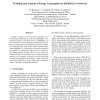Free Online Productivity Tools
i2Speak
i2Symbol
i2OCR
iTex2Img
iWeb2Print
iWeb2Shot
i2Type
iPdf2Split
iPdf2Merge
i2Bopomofo
i2Arabic
i2Style
i2Image
i2PDF
iLatex2Rtf
Sci2ools
ECUMN
2007
Springer
2007
Springer
Modeling and Analysis of Energy Consumption in IEEE802.11e Networks
Energy is a major concern in wireless networks, be it for the target mobile user, as is the case of IEEE802.11 Infrastructure mode, or for all the users as in IEEE802.11 ad hoc mode where it dictates the lifetime of the whole network. We focus in this paper on the modeling of energy consumption at the MAC layer in the context of QoS-capable WLAN, namely IEEE802.11e, and propose an analytical model for the lifetime of a terminal for different access categories. Our results quantify the impact of priority on energy consumption and show how the latter varies as a function of the network size, the number of stations in each priority group as well as the propagation environment : indoor versus outdoor. These results can be used at higher layers to optimize energy consumption through differentiation.
| Added | 07 Jun 2010 |
| Updated | 07 Jun 2010 |
| Type | Conference |
| Year | 2007 |
| Where | ECUMN |
| Authors | Olfa Bouattay, Tijani Chahed, Mounir Frikha, Sami Tabbane |
Comments (0)

